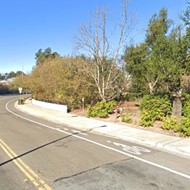[{
"name": "Newsletter Promo",
"id": "NewsletterPromo",
"class": "inlineCenter",
"insertPoint": "4",
"component": "15264767",
"requiredCountToDisplay": "0"
},{
"name": "Ad - Medium Rectangle CC01 - 300x250",
"id": "AdMediumRectangleCC01300x250",
"class": "inlineCenter",
"insertPoint": "8",
"component": "2963441",
"requiredCountToDisplay": "12"
},{
"name": "Ad - Medium Rectangle LC01 - 300x250",
"id": "AdMediumRectangleCC01300x250",
"class": "inlineCenter",
"insertPoint": "18",
"component": "2963441",
"requiredCountToDisplay": "22"
},{
"name": "Ad - Medium Rectangle LC09 - 300x250",
"id": "AdMediumRectangleLC09300x250",
"class": "inlineCenter",
"insertPoint": "28",
"component": "3252660",
"requiredCountToDisplay": "32"
}]
Friday, June 17, marked the final day of festivities for children attending Camp Tacanneko.
It was the culmination of a week-long summer camp held each year by the local nonprofit organization Camp Fire Central Coast. For the last 50 years, Camp Fire’s invited more than 7,500 local children to engage in a traditional camp experience on 29 acres of scenic woodlands located just a few minutes east of Highway 101 called Camp Arroyo Grande. That day might have been the last, last day of Camp Tacanneko. Ever.
“It could be the last day of that 50 years,” Camp Fire Executive Director Ken Miles told New Times.
That’s because Camp Arroyo Grande, which has been part of the community since the late 1800s, is for sale by its owner, the California branch of the United Methodist Church. This news raised concerns among some Arroyo Grande residents, who initiated a push to get the site a historic designation under the city’s municipal code.
The history of the land, referred to by locals as “The Methodist Camp” or “The Tabernacle,” dates back to before Arroyo Grande was even a city. The camp was dedicated in 1897 shortly after the completion of the 12-sided wooden building called “the tabernacle,” which still stands. According to Arroyo Grande resident and history buff Bill Hart, the site was the center for the culture and ideas that shaped early Arroyo Grande, bringing speakers who advocated for the temperance and women’s suffrage movements.
“In my mind, it is the most historical resource in Arroyo Grande, bar none,” Hart said.
Hart is also member of the city’s Historical Resources Committee, but said his comments to New Times reflected his personal views and were not made on behalf of the committee.
Over its nearly 120 years of existence, the land has changed hands multiple times. According to a March 2016 report on the camp given to the committee, John F. Beckett, one of the city’s historic founders, initially granted the land to the Arroyo Grande Methodist Episcopal Church. Eventually, ownership was transferred to Pasadena-based California-Pacific Conference of the United Methodist Church, where it became one of several sites used by the church for camping and retreats.
A listing for the property appeared online on the website for Kidder Mathews, a national real estate firm, earlier this year. While the listing does not name a price for the property, home prices indicate that the land, which Beckett donated to the church for just $1 in the 1870s, could turn a large profit. Documents included in the committee’s report showed the values of the homes near the campground ranging from $692,000 to more than $1.2 million.
James Buttery, a local lawyer representing the California-Pacific Conference of the United Methodist Church, spoke during the public comment portion of the Arroyo Grande City Council’s June 14 meeting to make it clear that the church was “formally against” the property receiving historical designation from the city.
“If the city continues this process and designates this 30-acre parcel with any historic designation, the church would suffer serious financial hardship,” Buttery told the council.
Buttery’s comments came months after the Historical Resources Committee voted to move forward with the first step of the historical designation process. At a March 11 meeting, the committee voted 3-0 to recommend that the tabernacle building and grounds be designated as a historic resource. According to the city’s municipal code, that recommendation will be passed on to Arroyo Grande’s Community Development Director Teresa McClish, who is authorized to grant a minor use permit for the designation. However, McClish said that due to a noticing error, the committee’s meeting and vote on the property need to be re-taken July 8.
Buttery indicated that the church would submit a resolution to the committee that would exempt the property from a historic designation because the church is a religious entity. That exemption is part of California’s government code.
“We expect the Historical Resources Committee will accept this exemption when it meets again in July,” Buttery said.
He also said the church was open to offering the city the wooden Tabernacle structure in a “disassembled state” that could be relocated to a public area.
While Buttery and the church are sure they can sell the property, Rick Barbezat isn’t. Barbezat, who lives in Santa Maria, is one of Beckett’s great-grandsons. He claimed the church’s plans to sell the property for profit violate the good faith of his ancestor’s initial agreements to donate the land more than a century ago.
“I’d rather see the property donated to the city or local nonprofit rather than the church make money,” Barbezat said.
As Camp Arroyo Grande’s fate hangs in limbo, so too does the future of Camp Tacanneko.
“I don’t know of a place that we could duplicate it,” Miles said. “I don’t know what we would use that would be as convenient and pristine as that campground.”
Staff Writer Chris McGuinness spent most his time at summer camp reading. He can be reached at [email protected], or on Twitter at @CWMcGuinness.
Latest in News
Readers also liked…
-

Coast Unified teachers upset over new position's salary and qualifications
Oct 20, 2022 -

SLO police identify alleged driver who hit and killed couple
Dec 22, 2022 -

When the levee breaks: Oceano residents, county officials walk a tightrope of regulations to manage Arroyo Grande Creek, which some say led to the levee's failure in January
May 18, 2023







